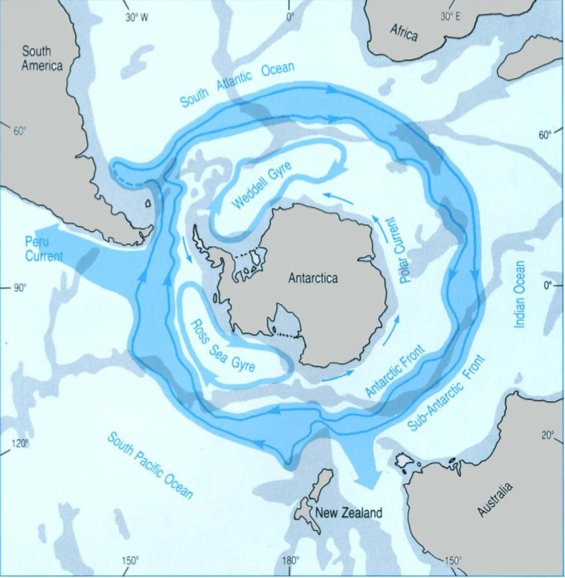Table of Contents
Southern Ocean Circulation
Author: Olivia
The Southern Ocean circulation consists of the cyclonic subpolar gyres in the Weddell and Ross Seas, the polar current and as the predominant feature of this region: the Antartic Circumpolar Current (ACC). It is the world's biggest ocean current and the only current that flows completely around the globe without encountering any land barrier. This feature enables to keep warm water away, letting the continent maintain it's huge ice sheet. As a result of the ACC there are also currents branching northward. In the following Figure the mentioned circulation patterns are shown:
The southern oceans role in the climate system
The southern ocean influences the climate in multiple ways:
- Because it connects the Indian, Atlantic and Pacific Ocean, the resulting global circulation of the ACC plays an important role in Oceans composition. It redistributes heat, influencing patterns of temperature and rainfall.
- It is an origin of dense cold water that is a driving force in the global circulation.
- The amount of sea ice in the southern ocean is of importance to the global climate: it accounts for an albedo effect and acts as a barrier to the atmosphere resulting in limiting heat loss in that region.
- As deep water is formated in the southern ocean, carbondioxid is effectely drawn from the system surface water and atmosphere.
Driving forces of the Southern Ocean circulation
Being on the southern Hemisphere Ekmann transport is to the left of the wind, and the surface water slopes downwards to the Antarctic continent. This sea-surface slope also generates a geostrophic current to the east, flowing in the same direction as the wind but extending to deeper regions than the wind driven surface layer. Below the surface, the density distribution is influenced by the horizontal pressure gradient force and the Coriolis force balance, and geostrophic equilibrium is maintained.
Antarctic Circumpolar Current
The Antarctic Circumpolar Current moves eastward — and at 24,000 km in length — it comprises the world's longest ocean current, transporting 130 million cubic metres of water per second. Combination of the Coriolis force and the direct effect of the westerly in the surface layers result in a northward component of flow. It is now known that there is a Zone consisting of a series of convergences that has been named the Antarctic Polar Frontal Zone (APFZ). The fronts are associated with strong zonal current jets. The Sub-Antarctic Front and the Antarctic Front mark the boundaries of the APFZ (also shown in previous image). The current isn't fast however very deep and therefore making the ACC the mightiest current in the oceans.
Meridional overturning circulation
The meridional overturning circulation is a system which connects the surface water and the deep currents of all oceans. It makes a connection between the surface ocean and atmosphere with the reservoir of the deep sea. The surface water can only sink down at certain key locations. Only in high latitude is the water dense enough because of its temperature dependancy. The different roles of the southern ocean in this process are the following:
- Deep water originated in the North Atlantik travels southward and will enter the ACC (also called the “giant mixmaster”) where the water will form a new identity. Some of this new water will flow northwards and fill the waters of the Pacific and Indian oceans.
- An area of deep and bottom water formation is also the Antarctic coast, including the Weddell and the Ross Seas. Formation of ice sheets in the Southern Ocean results in creating the densest waters of the world oceans which then flow northward.
References
- Antarctic Circumpolar Current: Retrieved May 2014 http://en.wikipedia.org/wiki/Antarctic_Circumpolar_Current
- The southern ocean and climate change - Academy of Science: Retrieved May 2014 http://www.sciencearchive.org.au/nova/018/018key.html
- IPCC - Intergovernmental Panel on Climate Change: Retrieved May 2014 http://www.ipcc.ch/ipccreports/tar/wg2/index.php?idp=602
- Ocean Circulation (Second Edition), Evelyn Brown et al. ISBN: 978-0-7506-5278-0 Chapter 5
- Wikipedia Southern Ocean Geography: Retrieved May 2014 http://en.wikipedia.org/wiki/Southern_Ocean#Geography
- Introduction: The Ocean’s Meridional Overturning Circulation Andreas Schmittner et. al http://people.oregonstate.edu/~schmita2/pdf/S/schmittner07agu_intro.pdf
